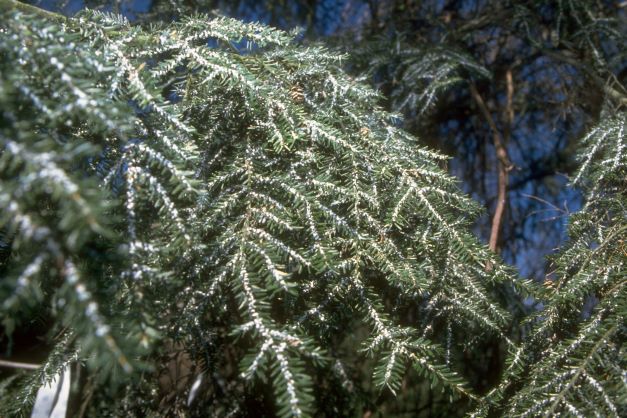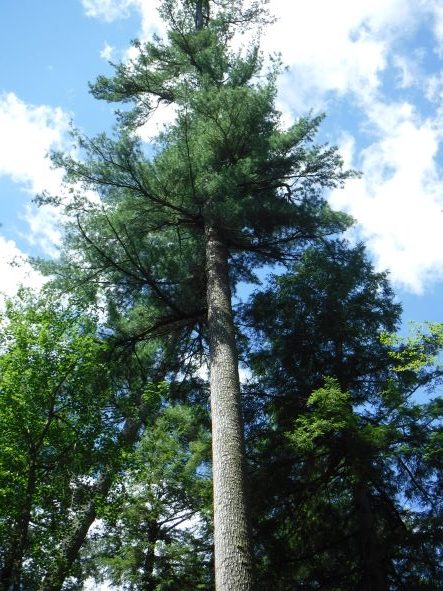
I recently posted a blog reviewing impacts of insects and pathogens on efforts to sequester atmospheric carbon in forests. I want to add two other studies. The first, by Weed, Ayers, and Hicke (2013; full citation at end of this blog), delved more deeply into three mechanisms by which climate and atmospheric changes associated with increasing greenhouse gases influence biotic disturbances: (1) effects on the physiology of insects and pathogens that cause changes in their abundance and distribution; (2) effects on tree defenses and tolerance; and (3) effects on interactions between disturbance agents and their own enemies, competitors, and mutualists. They also looked at interaction of tree-killing pests with other sources of forest disturbances – e.g., wildfires, drought, bioinvasions by organisms other than insects and pathogens, and human conversion of forested land to other uses. Tree-killing pests can promote destabilizing positive feedbacks with these other sources of forest disturbances. Weed, Ayers, and Hicke (2013) express the concern that recurrent forest disturbances caused by insects and pathogens might counteract carbon mitigation strategies. [This concern is similar to findings by Quirion et al. (2021) cited in the previous blog and by USDA Forest Service scientists studying disturbance agents in western forests (Barrett et al. 2021).
A second study by Clark and D’Amato (2021) looks intensively at forest growth and change in four types of secondary forests in New England to discover climate change dynamics and their resulting relative ability to sequester atmospheric carbon.
A 2013 Study by Weed, Ayers, and Hicke
Weed, Ayers, and Hicke (2013) begin from the premise that epidemics of forest insects and diseases (native and introduced) are the dominant sources of disturbance to North American forests. They note that, on a global scale, bioinvasions might be at least as important as climate change as threats to the sustainability of forest ecosystems. As agreed by most authorities, they find that the underlying cause of bioinvasions is propagule pressure from global transport, not climate change. However, climate change is strongly connected to management of continuing invasions.
Weed, Ayers, and Hicke (2013) review 79 studies published 1950 – 2012 which addressed a total of 27 insects and 22 diseases. Despite their opening focus on introduced pests, and the fact that six of the insects and nine of the diseases are nonindigenous, most of the research they were able to review has been on native organisms, principally on two species: the mountain pine beetle and southern pine beetle. Less is known about pathogens’ interaction with changes to climate than about insects’. A further complicating factor is the need to study both the insect and the pathogen when considering diseases vectored by insects (e.g., beech bark disease, oak wilt, Dutch elm disease, black stain root diseases, laurel wilt, thousand cankers disease, and pitch canker). [Profiles of most of these diseases are posted here; click on “invasive species”.] It is no surprise, then, that Weed, Ayers, and Hicke (2013) identify several areas where there is insufficient research. They state that despite scientists’ broad knowledge of climate effects on insect and pathogen demography, we still lack capacity to predict pest outbreaks under climate change.
Changing climatic conditions can exacerbate pest-caused disturbances by reducing winter mortality of insects and by increasing the development rate of insects and pathogens during the growing season. The changing conditions can also alter leaf maturation (which affects insect feeding) or synchrony of the life cycles of bark beetles. Contrary to the authors’ expectations, drought does not appear to cause a universal reduction in trees’ creation of defensive chemicals.
Due to pests’ host preferences, these disturbance agents typically alter the composition of tree species within stands – which can change forest types. For example, Weed, Ayers, and Hicke (2013) mention how mountain pine beetles shifted western forests from five needle pines toward subalpine firs. They do not mention balsam woolly adelgid or other fir pests.
The authors expect warming and increases in atmospheric CO2 to promote faster forest maturation in many US regions. Drought, however, will probably slow maturation rates in arid areas such as the southwest and intermountain regions. Climate change increases the likelihood that forest stands will be exposed to different and less suitable climates than those under which the current stands matured, making more stands susceptible to pests. (The USFS report on western forests said the same — Barrett et al. 2021). These changes tend to reduce the extent of mature forests and can adversely affect ecosystem services. They note the need for increased capacity to predict future patterns of biotic disturbances and integrate this knowledge with forest ecosystem science and the socioeconomics of human land use.
Weed, Ayers, and Hicke (2013) raise an interesting point regarding the impact of disturbance factors on trees’ ages and sizes. They mention specifically reduction in numbers of large-diameter beech trees due to beech bark disease and elms due to Dutch elm disease. Several large-growing trees, e.g., American chestnut and white pines, have been virtually eliminated from much of their historical ranges. They express the fear that emerald ash borer, sudden oak death, butternut canker, and laurel wilt are in the early stages of having a similar effect on their hosts. [Profiles of most of these pests are posted here; click on “invasive species”.] Weed, Ayers, and Hicke (2013) note the importance to wildlife of this shift – the loss of mature forest habitat changes availability of food supplies, nest cavities, etc. The authors do not relate these specific pest-mediated changes to the climate change-caused alterations. However, they do note that pest impacts exacerbate a situation already arising from loss of mature forests due to human land use patterns.
Weed, Ayers, and Hicke (2013) mention changes in elemental cycling and hydrologic processes resulting from pest-caused mortality; they refer to several studies by Lovett, especially Lovett et al. (2006). These changes can have long-lasting effects on productivity, biodiversity, and elemental cycling. Among them are effects on water transpiration and increased soil moisture and runoff. I had blogged earlier about these impacts as they pertain to black ash swamps. At high elevations, snow accumulates more deeply on the ground while snowmelt is more rapid because loss of canopy will decrease interception of snow by the canopy (leading to reduced sublimation and redistribution of snow) and increase solar radiation to the forest floor.
Weed, Ayers, and Hicke (2013) anticipate that pest outbreaks under climate change will commonly produce persistent changes in the feedbacks that connect biotic communities and elemental cycling.
Weed, Ayers, and Hicke (2013) summarize their findings as follows:
1) Epidemics of forest pests (native and introduced) exceed other sources of disturbance to North American forests.
2) Insect populations are highly responsive to climate change due to their physiological sensitivity to temperature, high mobility, short generation times, and explosive reproductive potential. Pathogens and declines are also strongly influenced by climate change due to their sensitivity to temperature and moisture. These effects have proven to be more dramatic than expected in the case of pine bark beetles. There is no discussion of whether other insect-host relationships might differ substantially.
3) Changes in biotic disturbance regimes have broad consequences for forest ecosystems and the services they provide to society.
4) Climatic effects on forest pest outbreaks might beget further changes in climate by influencing the exchange of carbon, water, and energy between forests and the atmosphere.
5) In some areas, climate-induced changes might result in increased or decreased disturbance risk.

A 2021 Study by Clark and D’Amato
Clark and D’Amato (2021) focused on a research site in New England which provided 69 years of data on succession dynamics. The site has four types of secondary forests. Clark and D’Amato (2021) found that mixed hardwood (oak)-pine systems dominated by large diameter eastern white pine (Pinus strobus) exhibited the greatest increase in biomass over the 69-year period and thus performed best as carbon sinks. These forests also had the greatest structural complexity.
However, these “mixedwood” systems are largely an artifact of past clearing for agriculture and are naturally trending toward greater domination by hardwoods. In fact, new trees growing in all four forest types were predominantly shade-tolerant beech (Fagus grandifolia) and hemlock (Tsuga canadensis). Clark and D’Amato (2021) note that these species are both less compatible with predicted future climatic conditions and are under attack by non-native pests — beech bark disease and hemlock woolly adelgid, respectively. The article makes no mention of possible complications from two other pests of beech, beech leaf disease and beech leaf weevil. [All three pests have profiles here.]
They conclude that if the goal is to maximize carbon sequestration in forests – while maintaining structural complexity – managers must adopt silvicultural strategies intended to maintain the pine component. This strategy is not without risk. Mature white pine constitutes 68% of the biomass in the mixedwood stands. Clark and D’Amato (2021) note that a strategy relying so heavily on one species exposes that strategy to a high risk of catastrophic losses due to stochastic disturbance-related mortality, emerging forest health issues, and/or selective timber harvests targeting the largest trees. Of course, eastern white pine has already survived one pest, white pine blister rust.
SOURCES
Barrett, T.M. and G.C. Robertson, Editors. 2021. Disturbance and Sustainability in Forests of the Western United States. USDA Forest Service Pacific Northwest Research Station. General Technical Report PNW-GTR-992. March 2021
Clark, P.W. and A.W. D’Amato. 2021. Long-term development of transition hardwood and Pinus strobus – Quercus mixedwood forests with implications for future adaptation and mitigation potential. Forest Ecology and Management 501 (2021) 119654
Lovett, G.M., C.D. Canham, M.A. Arthur, K.C. Weathers, and R.D. Fitzhugh. 2006. Forest Ecosystem Responses to Exotic Pests and Pathogens in Eastern North America. BioScience Vol. 56 No. 5 May 2006)
Lovett, G.M., M. Weiss, A.M. Liebhold, T.P. Holmes, B. Leung, K.F. Lambert, D.A. Orwig, F.T. Campbell, J. Rosenthal, D.G. Mclimate changeullough, R. Wildova, M.P. Ayres, C.D. Canham, D.R. Foster, S.L. Ladeau, and T. Weldy. 2016. Nonnative forest insects and pathogens in the United States: Impacts and policy options. Ecological Applications, 26(5), 2016, pp. 1437-1455
Poland, T.M., Patel-Weynand, T., Finch, D., Miniat, C. F., and Lopez, V. (Eds) (2019), Invasive Species in Forests and Grasslands of the United States: A Comprehensive Science Synthesis for the United States Forest Sector. Springer Verlag.
Weed, A.S., M.P. Ayers, J.A. Hicke. 2013. Consequences of climate change for biotic disturbances in North American forests. Ecological Monographs, 83(4), 2013, pp. 441–470
Posted by Faith Campbell
We welcome comments that supplement or correct factual information, suggest new approaches, or promote thoughtful consideration. We post comments that disagree with us — but not those we judge to be not civil or inflammatory.
For a detailed discussion of the policies and practices that have allowed these pests to enter and spread – and that do not promote effective restoration strategies – review the Fading Forests report at http://treeimprovement.utk.edu/FadingForests.htm